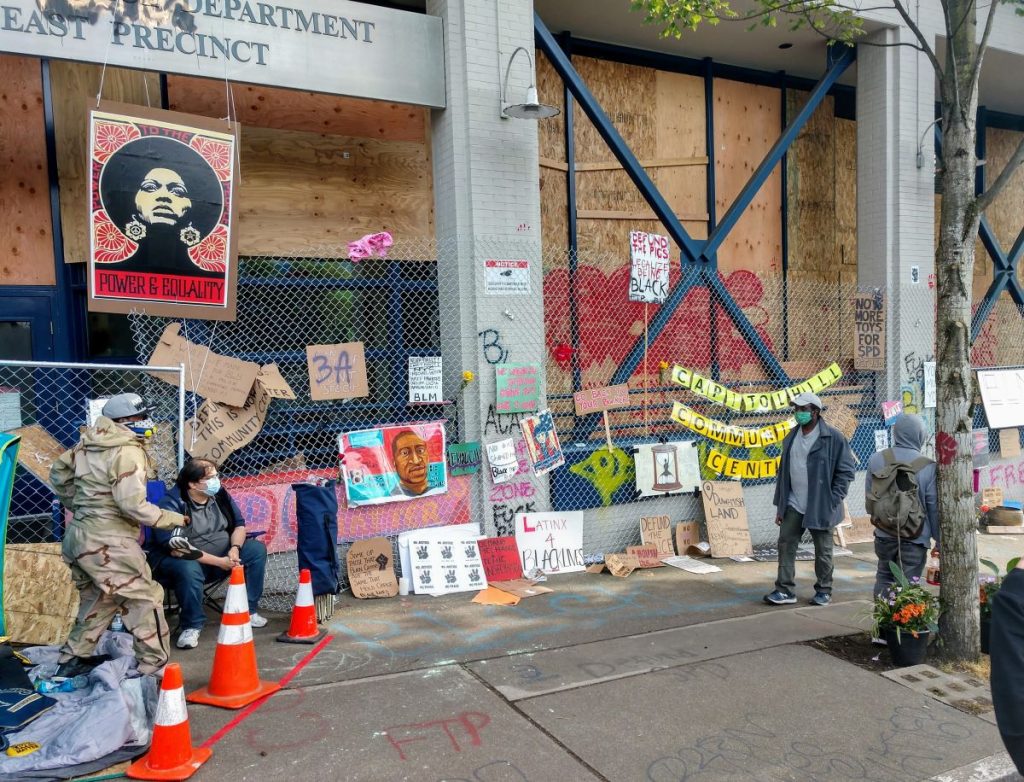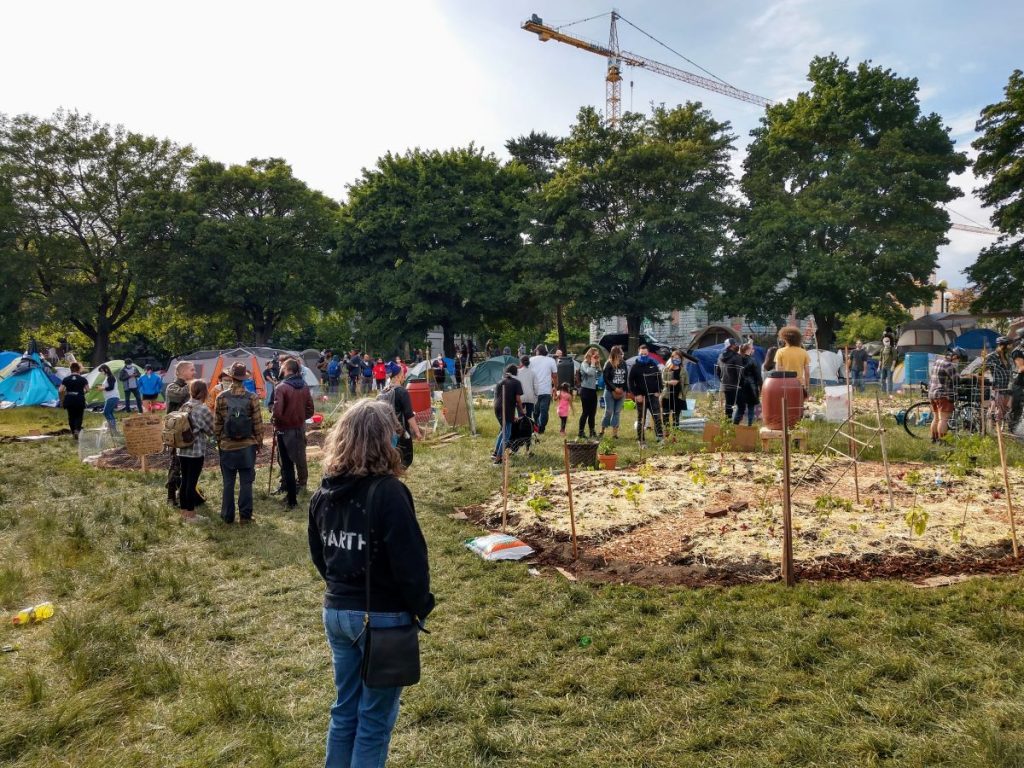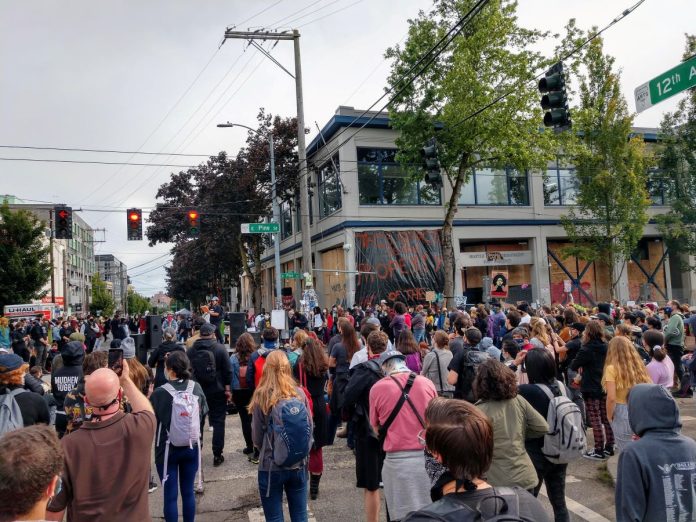The power in urban design lies its ability to provide a lens into the future. It allows communities to project themselves, their families, their values, into the built environment to create spaces that are affirming, safe, and prosperous. In the American urban context, this right has largely been denied for non-White immigrants and communities of color. Structural and institutionalized racism, segregation, and economic inequality have been baked into our sidewalks and reinforced with each generation. The systems that were built to serve and protect us have failed. We are concurrently experiencing a global health crisis, and at large, a crisis of community.
Claiming autonomy is a powerful act of rebellion against the systems that we know and serve. What is being experienced in Capitol Hill is an opportunity for Black and Brown communities to demand justice. A historic moment to reframe the way we police our communities, educate our children, and provide economic opportunities for those who live in our city. The Capitol Hill Organized Protest (CHOP) has forced the City of Seattle to address these systemic shortcomings in more concrete terms. I believe it is the duty of planners and designers of the built environment to preserve, and enhance the equity, livability, safety, and health in our communities, and this cannot be done without earning the trust of the communities they serve. In order to do so, communities need to be empowered at a granular level.
Top-down planning has created and perpetuated a system that provides equality at best but will never be able to truly serve each of its communities equitably. In order for cities to meaningfully match the needs of its neighborhoods and diverse residents, they need to deploy an asset-based approach to community development. The collective power held by private citizens makes grassroots community-level organization critical to disrupting traditional market-based approaches to land use and urban planning.
Asset-based community planning organizes the resources of an existing group to benefit the community as a whole. This approach emerged from the DNA of community organizers and is vital for the success and establishment of a just future for urban spaces, especially in underserved neighborhoods. The power of this model is that it asks communities to focus on existing capacities and their ability to effect change. Asset-based planning theory intersects spatially-fixed social justice practices as it encourages equity in the planning process.
John Kretzmann and John McKnight, Co-Directors of the Asset Based Community Institute, published on the collective power of community assets. Kretzmann and McKnight write that “historic evidence indicates that significant community development take place only when local community people are committed to investing themselves and their resources in the effort”. They suggest that communities are never effectively built from the top down but must be self-generated from the inside out. This growth strategy is a display of asset-based community engagement, accepting the community as a collective asset through labor, materials, property, and funding.
Historical Context
Protest and civil disobedience are not new to the City of Seattle. Through the struggle for justice and commitment to community values, civil disobedience has created measured value in the built fabric of Seattle. These stories of protest and triumph are sewn into Seattle’s urban fabric and have given this city so many significant landmarks and cultural spaces. So often, when communities of color have pursued the formal channels for action and representation, they have been met with silence, and because of that, power must be taken in a visible manner. Autonomy is then used as a bargaining chip. There are three specific instances withing the last 50 years where peaceful protest and occupation have led to meaningful and permanent change.
Northwest African American Museum
The previously vacant Coleman School was occupied in 1985 after a fruitless search was conducted by the City of Seattle to find a suitable location for a community supported African American Museum. During the occupation, the group known as the Citizens Support Committee for the African American Heritage Museum, used the Coleman school as a place to display artwork, host community events, and provide public health education. In 1993, the eight-year occupation was lifted, and the City of Seattle agreed to fund the museum. After another decade of lawsuits and disagreements, the building was purchased from the City of Seattle and opened in 2008 as The Northwest African American Museum.
This occupation occurred after three years of inaction by the city to find a location to celebrate and highlight the history of African Americans in the Pacific Northwest. The failure of the city to meet the needs of its residents called for action and required eight years of protest and self-sacrifice to elicit a response from the City. Then another fifteen years before the vision was complete. Today, the Northwest African American Museum is a vibrant place that fosters multicultural inclusion, learning, and community.
El Centro de la Raza
In fall of 1972, a group of Latino students and ten staff members were left without an educational home because of the closure of their English and Adult Basic Education Program. After a visit to the vacant Beacon Hill School, Robert Maestas and a group of activists resumed their education in the Beacon Hill School building. During the occupation, there were organized protests in the chambers of the City Council. After three months of occupation, the City of Seattle offered a five-year lease at just $1 a year. Then, in 1997, the school district demanded that the tenants pay fair market value for the rental of the space and raised the rent to $12,000 a month. By 1999, El Centro had secured enough in grants to buy the site from the school district. El Centro de la Raza sought to provide a gathering space for Seattle’s Latino diaspora. This vision took nearly 30 years to materialize.
Daybreak Star Indian Cultural Center
In 1970, 1,100 acres of land surrounding Fort Lawton in the Magnolia neighborhood was decommissioned from military use. Once the military base was declared surplus, Bernie Whitebear and United Indians of All Tribes Foundation (UIATF) saw an opportunity to reclaim this land for the native community. Whitebear lead a non-violent occupation of Fort Lawton while seeking ways to legally purchase the land from the U.S. Department of Defense. The Bureau of Indian Affairs was able to freeze the purchase of the land at a federal level, preventing the City of Seattle from legally acquiring it. After presenting their case, former Governor of Washington Daniel J. Evans granted the UIATF a construction grant. The Daybreak Start Indian Cultural Center then opened its doors in 1977 as a gathering space for both native and non-native groups.
These three examples illustrate how communities of color have used autonomy as a bargaining chip to create safe and affirming spaces. Now the CHOP has the same opportunity, but for the Black Lives Matter movement at a city scale. These are all decade long struggles that required a remarkable amount of determination and self-sacrifice. Ultimately, the city had the capacity to meet the demands of the protesters, but I would offer a way to reframe it. These were only demands once the needs of those communities were left unmet and unheard.
The Capitol Hill Occupied Protest
Conventional forms of urbanism have led to the displacement and exclusion of marginalized communities for centuries. These pressures have been felt in the heavily gentrified Capitol Hill neighborhood of Seattle. Former auto-row, now night life center of the city, Capitol Hill has become one of the most expensive neighborhoods in Seattle. Ultimately, urbanity transcends beyond an understanding of the built form and offers a commentary on the economic forces that have been extended to concentrate and circulate capital surplus. With the establishment of the CHOP, the core of the Pike Pine district is being fundamentally restructured through grassroots tactical urbanism. Tactical urbanism signals that conventional planning and design regulations are not meeting the complex needs of society and therefore need to be reevaluated, which is where asset-based planning can be the most effective.

The 30 demands issued by some members of the CHOP are centered around the reform of the justice system, improved economic equity and rent control, education reform, and that public health services are centered in the future of policing. The list of demands begins with a proclamation, “This document is to represent the black voices who spoke in victory at the top of 12th & Pine after 9 days of peaceful protest while under constant nightly attack from the Seattle Police Department.”
The central demand is squarely focused on defunding and abolishing the police and creating a new system of public safety that is focused on restorative justice. The people of Free Capitol Hill demand that the funding that was previously used for the Seattle Police Department be redirected into five specific areas:
- Socialized health and medicine.
- Public housing, because housing is a right, not a privilege.
- Public education, to decrease the average class size in city schools and increase teacher salary.
- “Naturalization services for immigrants to the United States living here undocumented. (We demand they be called ‘undocumented’ because no person is illegal.)”
- General community development, such as parks.

These demands imagine a more equitable future for everyone who lives in the City of Seattle, especially Black and Brown communities. More importantly, these are demands for a better future with a people-focused approach. Restaurants have been preparing food for protesters at no cost, medics are providing their expertise and time, and citizens are donating supplies in the newly designated zone. A community garden has been planted and seeded with the labor and expertise of community members. This effort has been spearheaded by Marcus Henderson, an urban planner and Stanford graduate, has worked on sustainable agriculture projects around the world.
“We’re dealing with a question of how Black people have been disenfranchised for so long, pulled out of the economic system,” Henderson said in an interview with The Stranger. “One way of doing that is not giving people access to land.”
Thus, the CHOP is asset-based community planning in action.
Planners and policymakers see unplanned or informal activities as peripheral events that should be ignored at best, and at worst as unsanctioned actions that require punishment and prosecution. This binary fails to embrace the complexity of informality and learn from what the community is showing you it needs the most. If done correctly, the City can begin to incorporate this approach by matching its programs and resources to community needs at a neighborhood scale. While the outcome is yet to be written, the CHOP is a bold rejection of the status quo in one of the most central neighborhoods in Seattle. One that came from a place of systemic disenfranchisement and oppression. As evidenced by the historical precedents, holding space in the built form is an important and resilient reminder of the hard-fought victory.
Autonomy is a bargaining chip. As Charles Mudede alluded to in his piece “The Future of Capitol Hill’s New Autonomous Zone Is Predictable”, the CHOP will likely be institutionalized and folded back into the formal network of the city. What is yet to be determined is what the institutional and systemic costs will be for the CHOP to do so. It is about the exchange of power and how the Black and Brown community can use this platform to fight for a truly equitable city. If history can be the guide, the demands that the CHOP published are an important challenge to, and will act as a measuring stick for, the City of Seattle’s commitment to social justice and equity work. Moreover, it’s the beginning of a dialogue for asset-based alternatives and offers the world an example of what a healthy community can look like without an omnipresent police force.
This change does not need decades before coming to fruition. As exemplified by El Centro, the Northwest African American Museum, and The Daybreak Center, all this requires is political will and dedicated leadership at the community level.
Editor’s note: This article has been updated to use Capitol Hill Organized Protest (CHOP) rather than “Capitol Hill Occupied Protest.”

Hayden Campbell (Guest Contributor)
Hayden Campbell is an urban designer and PNW native invested in equitable community design centered around issues of access and social justice. These interests are principally driven by the historical inequities perpetrated by planning in the American urban context.




